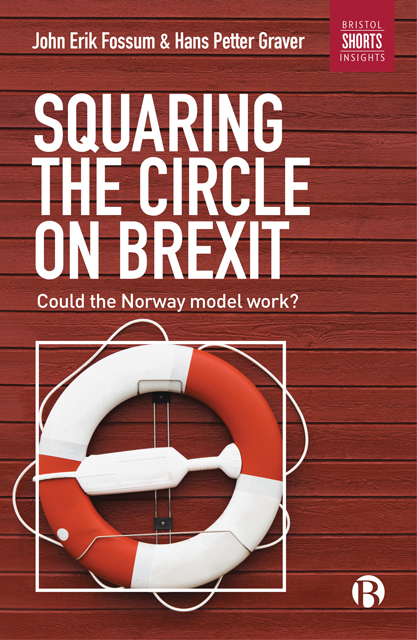Book contents
- Frontmatter
- Contents
- Foreword
- Preface and acknowledgements
- List of abbreviations
- Introduction
- 1 What does Britain want from Brexit?
- 2 Forms of affiliation with non-members
- 3 What is the Norway model?
- 4 The challenge of sovereignty
- 5 What can Britain learn from Norway’s experience?
- 6 Would Britain be an ‘elephant in the boat’?
- Conclusion
- Notes
- References
- Appendix
- Index
Introduction
Published online by Cambridge University Press: 21 April 2023
- Frontmatter
- Contents
- Foreword
- Preface and acknowledgements
- List of abbreviations
- Introduction
- 1 What does Britain want from Brexit?
- 2 Forms of affiliation with non-members
- 3 What is the Norway model?
- 4 The challenge of sovereignty
- 5 What can Britain learn from Norway’s experience?
- 6 Would Britain be an ‘elephant in the boat’?
- Conclusion
- Notes
- References
- Appendix
- Index
Summary
After seven decades of integration of Europe, cracks are appearing. The United Kingdom’s decision to leave the European Union after the negative referendum result on 23 June 2016 is the most dramatic instance thus far of rejecting the EU’s credo of ‘ever closer union’. There have been membership referendum rejections in the periphery of Europe (Norway 1972 and 1995, Switzerland 1994), and treaty and other referendum rejections within the EU itself. Nevertheless, the decision of a major member state to exit the Union is unprecedented. Brexit (combined with the EU’s other crises) has prompted reflection and debate on the EU’s further development. At the same time, and especially for an entity that Jacques Delors has depicted as a UPO or unidentified political object, the way it handles the loss of a major member offers important insights into the system’s self-conception. What is apparent from the manner in which the EU has handled the process of Brexit thus far is that it sees itself as a legal and political entity, and even if it is not a state, it has elements of stateness and responds to such momentous developments in a state-like manner. At the same time its functions and scope of action are defined by treaties that give wide powers to the Court of Justice to define and limit the action of the institutions and the member states. As we shall see, that clearly shapes the process and what the EU is prepared to offer to the UK.
The UK’s decision to exit the EU will situate it in a new category of state in Europe: that of ex-member state (Lord, 2015). Once the UK leaves the EU, almost regardless of the shape of its future relationship to the rest of Europe, it will be part of a heterogeneous group of states that are associated with the EU, as the UK will most likely have some form of association with the EU post-Brexit. It is therefore useful to search for possible analogies in order to see if they hold relevant lessons for the UK.
The states that are not members of the EU but instead have some form of association with it vary greatly with regard to the range and density of association, and in terms of whether or not they qualify for EU membership (Gstöhl, 2015).
- Type
- Chapter
- Information
- Squaring the Circle on BrexitCould the Norway Model Work?, pp. xi - xviiiPublisher: Bristol University PressPrint publication year: 2018

